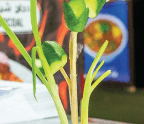Sound Tracks: An Interview with Simone Forti

Simone Forti, 2012. “Someone must have handed me a piece of flexible tubing from the hardware store and shown me that I could play it, the pitch rising and falling according to how hard I’d blow through it. It was around 1970. I tied a red kerchief to this horn and called it my molimo, after the instrument the Mbuti Pygmies play to wake up their mother, the forest … They claim that the molimo is the sound, not the object.” (From the notes in Al Di Là.) Photo: Jason Underhill
Simone Forti is primarily known as a central figure in American postmodern dance, but her work in movement has always been interdisciplinary. The foundational pieces she called Dance Constructions, for instance (first performed at the Reuben Gallery in 1960, and, the following year, in Yoko Ono’s loft), were, as the name implies, sculptural as well as choreographic.Lesser known are the soundscapes she’s created, both alone and with others, throughout her career. The first time her sonic experiments received serious attention was in a 2012 gallery show, “Sounding,” at the Box Gallery in Los Angeles. The exhibition featured recordings of her soundscapes alongside projections and images of original performances; the gallery included areas with benches, carpeting, and earphones where visitors could, presumably, close their eyes and pay focused attention to those
You’re reading a preview, subscribe to read more.
Start your free 30 days

